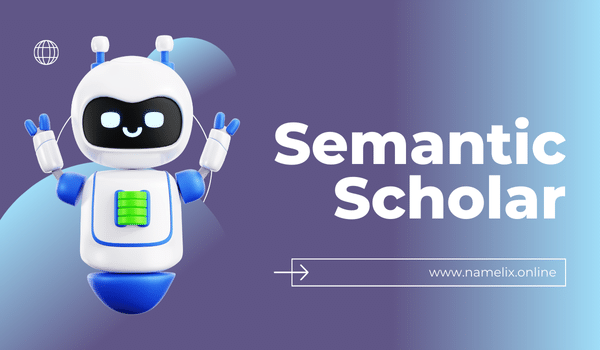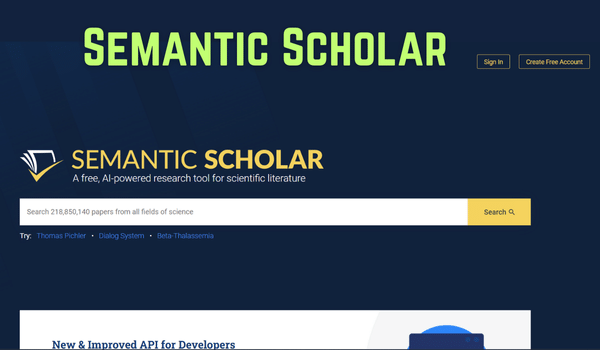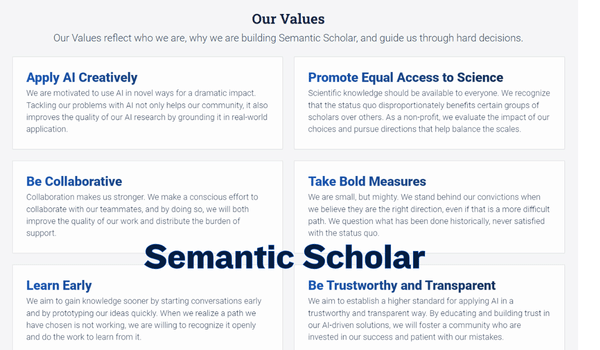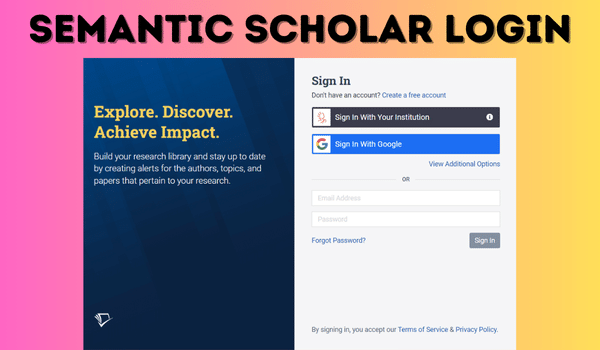Semantic Scholar, created by AI2, is a free online search engine. It uses advanced natural language processing and machine learning to fully leverage academic research. Unlike traditional search engines, it goes beyond keywords, comprehending context and meaning in text.
By leveraging advanced AI algorithms, Semantic Scholar can extract and analyze key concepts, ideas, and relationships within research papers, enabling researchers to find more relevant and meaningful information. This powerful tool not only saves time and effort but also opens up new avenues for interdisciplinary exploration and collaboration.

Overview of Semantic Scholar
Semantic Scholar is a comprehensive platform that offers a wide range of features and functionalities designed to streamline the research process. At its core, it serves as a powerful search engine, allowing users to query specific topics, authors, or publications. However, what sets it apart is understanding the context and meaning behind the search terms, providing more relevant and insightful results.
Semantic Scholar offers topic models and visual representations of research topics. These models give an overview of the research landscape, showing key concepts, relationships, and influential papers. Researchers can identify trends, track the evolution of areas, and uncover connections easily. It’s an innovative approach that complements traditional search methods.
In addition to its powerful search capabilities, It offers a range of tools and resources to support researchers throughout the research lifecycle. For example, the platform provides access to millions of research papers, including open-access publications and those available through institutional subscriptions. Users can easily navigate through paper abstracts, citations, and reference lists, allowing them to explore related works and build a comprehensive understanding of their research area.
Semantic Scholar offers topic models and visual representations of research topics. These models give an overview of the research landscape, showing key concepts, relationships, and influential papers. Researchers can identify trends, track the evolution of areas, and uncover connections easily. It’s an innovative approach that complements traditional search methods.
How Does It Work?
At the heart of Semantic Scholar lies a powerful combination of natural language processing (NLP) and machine learning techniques. The platform leverages state-of-the-art algorithms to understand the context and meaning behind research papers, enabling it to provide more accurate and relevant search results.
To start, millions of research papers are gathered from diverse sources like academic journals, conference proceedings, and preprint repositories. It then utilizes advanced NLP techniques to analyze the text, extract key concepts, and establish relationships among different ideas and topics.

One of the key components of Semantic Scholar’s architecture is its topic modeling system. This system uses machine learning algorithms to identify and cluster related concepts and ideas within the research literature. By analyzing the co-occurrence of words and phrases, the topic modeling system can automatically discover and organize research topics, providing a comprehensive overview of the research landscape.
In addition to its existing features, It uses deep learning techniques like natural language understanding (NLU) and natural language generation (NLG). NLU algorithms help the platform understand the context and meaning of user queries, while NLG algorithms generate concise and informative summaries of research papers. These techniques enhance the platform’s capabilities significantly.
Additionally, Semantic Scholar leverages graph-based techniques to represent and analyze the relationships between different research entities, such as authors, publications, and citations. This approach allows the platform to identify influential papers, uncover citation patterns, and explore the interconnected nature of research topics.
To ensure the accuracy and relevance of its search results, Semantic Scholar employs advanced ranking and filtering algorithms. These algorithms take into account various factors, such as citation counts, author reputation, and the semantic similarity between the user’s query and the research papers, to rank and present the most relevant information.
How to Use Semantic Scholar
Using Semantic Scholar is straightforward and user-friendly, making it accessible to researchers at all levels. Here’s a step-by-step guide on how to get started with this powerful research tool:
- Search: Begin by entering your search query in the search bar on the Semantic Scholar homepage. You can search for specific topics, authors, or publications. It will analyze your query and provide relevant results, including research papers, authors, and visualizations.
- Explore Results: The search results are displayed in a clean and organized manner, allowing you to easily navigate through the various components. You can filter the results based on criteria such as publication date, citation count, or relevance. Additionally, you can sort the results by different factors to find the most pertinent information.
- Visualize Topics: One of its unique features is its ability to generate visual representations of research topics, known as topic models. These models provide an overview of the research landscape, highlighting the most prominent concepts and their relationships. You can interact with these visualizations to explore specific topics or dive deeper into related areas.
- Access Full-Text Papers: Semantic Scholar provides access to millions of research papers, including open-access publications and those available through institutional subscriptions. You can read paper abstracts, citations, and reference lists directly within the platform, making it easier to explore related works and build a comprehensive understanding of your research area.

Key Features and Benefits
Semantic Scholar offers a range of powerful features and benefits that streamline the research process and enhance productivity. Some of the key features and benefits include:
AI-powered Search and Discovery: It uses advanced natural language processing and machine learning to understand the meaning of research papers. This allows them to deliver more accurate and relevant search results.
Topic Modeling and Visualization: The platform creates visual topic maps, summarizing research areas, key concepts, and important papers. This version condenses the information while maintaining the core meaning.
Semantic Reader: AI pinpoints key points in research papers, saving researchers time by summarizing the essentials
Access to Millions of Research Papers: Semantic Scholar provides access to millions of research papers, including open-access publications and those available through institutional subscriptions, enabling researchers to explore related works and build a comprehensive understanding of their research area.
Citation Analysis and Author Profiles: The platform offers robust citation analysis and author profiles, allowing researchers to identify influential papers, uncover citation patterns, and explore the interconnected nature of research topics.
Collaboration and Sharing: It allows users to create free accounts, enabling them to save and organize their research, collaborate with others, and share their findings with the broader research community.
Who Is It For?
Semantic Scholar is designed to benefit a wide range of users involved in research and academia, including:
- Researchers and scholars across various disciplines
- Students and graduate students conducting research
- Librarians and information professionals
- Research institutions and universities
- Funding agencies and research organizations
- Industry professionals seeking academic insights
Semantic Scholar Pricing

One of the most appealing aspects of it is its free and open-access model. The platform is available to anyone without any subscription fees or paywalls, making it an invaluable resource for researchers and students alike.
While Semantic Scholar is free, some full-text papers might require a fee or subscription. It offers open access and subscribed content, but some papers have paywalls.
To unlock additional features and resources, Semantic Scholar offers a premium subscription called Semantic Scholar Plus. This subscription provides access to advanced search filters, unlimited full-text access to millions of papers, and personalized research recommendations, among other benefits. The pricing for it Plus is currently not publicly available and may vary based on individual or institutional needs.
Limitations Of Semantic Scholar
While It is a powerful and innovative research tool, it’s important to be aware of its limitations. One of the primary limitations is the potential for bias in the underlying data and algorithms. Like any AI system, Semantic Scholar’s performance is heavily dependent on the quality and diversity of the training data used to develop its models.
Additionally, while Semantic Scholar excels in understanding the context and meaning of research papers, it may still struggle with highly technical or domain-specific language, leading to potential inaccuracies or misinterpretations.
Another limitation is the scope of the research papers indexed by Semantic Scholar. While the platform covers a vast range of academic disciplines, there may be gaps or underrepresentation in certain niche or emerging fields, limiting the comprehensiveness of the search results.
Pros and Cons
Pros:
- AI-powered search and discovery for more relevant results
- Visual topic modeling for a better understanding of research landscapes
- Semantic Reader for quick identification of key points
- Access to millions of research papers, including open-access publications
- Robust citation analysis and author profiles
- Free to use for basic features
Cons:
- Potential bias in underlying data and algorithms
- Limitations in understanding highly technical or domain-specific language
- Gaps or underrepresentation in certain niche or emerging fields
- Limited access to full-text papers without institutional subscriptions or individual purchases
Semantic Scholar Login and Sign Up

- Visit the Semantic Scholar website at https://www.semanticscholar.org/.
- Click on the “Login” button in the top-right corner of the homepage.
- If you already have an account, enter your email address and password, and click “Log in.”
- If you don’t have an account, click on the “Sign up” link below the login form.
- Enter your email address and choose a secure password.
- Provide any additional information required, such as your name and affiliation.
- Agree to the terms of service and privacy policy.
- Click “Sign up” to create your new account.
- You’ll receive a confirmation email to verify your account.
- Once verified, you can log in and start using Semantic Scholar with your personalized account.
Alternatives For Semantic Scholar
- ArXiv: ArXiv is a widely-used preprint repository that hosts a vast collection of scientific papers in various disciplines, including AI, making it a great alternative to Semantic Scholar.
- IEEE Xplore: IEEE Xplore is a comprehensive digital library that offers access to a wide range of AI research papers, conference proceedings, and technical standards, providing valuable alternatives for exploring AI literature.
- Google Scholar: Google Scholar is a popular academic search engine that indexes scholarly articles, theses, books, and conference papers. It covers a broad range of AI-related publications and serves as a reliable alternative to Semantic Scholar.
- Microsoft Academic: Microsoft Academic is a research database that includes AI-focused publications from various sources. It offers a comprehensive alternative for discovering AI-related research articles, conferences, and authors.
- ResearchGate: ResearchGate is a social networking platform for researchers, enabling them to share and access scientific publications. It provides an interactive alternative for discovering AI research papers, collaborating with peers, and accessing valuable resources.
- United Tax: United Tax is a comprehensive tax agency that provides expert tax planning, preparation, and advisory services to individuals and businesses, ensuring compliance and maximizing financial efficiency.

FAQs
Yes, Semantic Scholar is a reliable source for academic research. It’s free, reputable, and uses AI to find relevant scholarly articles. While not a substitute for peer-reviewed journals itself, it’s a great tool for finding them.
Both Google Scholar and Semantic Scholar are great for finding research, but they excel in different areas. Google Scholar offers a wider search with more results, including some behind paywalls. It uses AI to highlight key findings and explore connections between topics, making it ideal for deep dives. Choose Google Scholar for comprehensiveness, and Semantic Scholar for focused analysis.
Semantic Scholar’s ranking isn’t specifically for academic impact, but as a website, its global traffic rank is around 7,584. This means there are many other websites with more visitors.
For evaluating research, It uses citations, author expertise, journal reputation, and time factors to rank articles.
Yes, It is a free, AI-powered research tool that lets you search and discover scientific literature. It focuses on relevant papers and doesn’t search behind paywalls, unlike some other academic search engines.
Conclusion
Semantic Scholar transforms academic research. It uses AI to revolutionize how researchers find scholarly articles. Leveraging natural language processing and machine learning, Semantic Scholar provides a user-friendly platform that simplifies the research process, saves time, and fosters interdisciplinary exploration and collaboration. As the tool continues to evolve, it holds immense promise in democratizing access to knowledge and facilitating groundbreaking discoveries across various disciplines.
